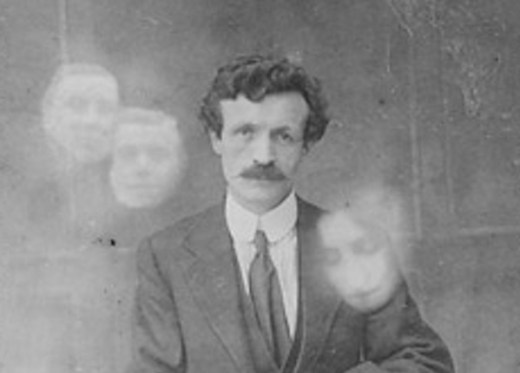Have you seen any old photos with ghostly images? Chances are you may be looking at an old spirit photograph. During the late 19th and early 20th centuries, spirit photography became incredibly popular. Many people came to believe that spirit photographers could capture the image of a deceased loved one in a photograph.
Check out these 7 facts about the history of spirit photography:
Preus Museum, Flickr
1. Spirit photography was discovered by accident by William H. Mumler in the early 1860s.
Preus Museum, Flickr
One of the earliest forms of spirit photography was discovered by accident by William H. Mumler. While developing a self-portrait, he found that the image appeared to show an apparition of his deceased cousin. Mumler discovered that double exposure could create a ghostly image in a photo. Using this new technique, Mumler embarked in a new frontier, “spirit photography.” Mumler would take a photo of a living person and doctor the photograph with the image of a deceased person to give the effect that the person was visiting from the dead.
2. Mumler was exposed as a fraud with the help of P.T. Barnum.
The Evening Telegraph, April 29, 1869 / Library of Congress
Mumler found much success as a full-time spirit photographer. However, many critics were skeptical of his spirit photographs and some accused him of breaking into people’s homes to steal photographs of deceased relatives. Mumler’s downfall began when people began to recognize that the “spirits” in the photographs were in fact still alive. Mumler was eventually taken to trial for fraud in 1869. Showman P.T. Barnum testified against him and explained how the images could be faked. Although Mumler was ultimately acquitted due to a lack of evidence, his photography career never recovered.
3. Spirit photography was immensely popular in the late 19th and early 20th century.
Preus Museum, Flickr
Despite accusations of fraud, spirit photography became immensely popular in the late 19th and early 20th century alongside the rise of the Spiritualist movement. The large death toll of the American Civil War left many people in mourning for their lost relatives. Many turned towards spiritualism as a way to connect with their deceased loved ones after death. With the climate ripe for spirit photographers, many fraudsters turned spirit photography into a lucrative business.
4. Photographer William Hope founded the Crewe Circle, a group of six spirit photographers based in Crewe, England.
National Science and Media Museum, Flickr
The Crewe Circle was a group of six spirit photographers led by William Hope, a former carpenter turned photographer. The group worked in secret until the Archbishop Thomas Colley joined the group. With the addition of the Archbishop, the group gained some legitimacy and began to publish their work publicly. After the end of World War I, the demand for the Crewe Circle’s services grew and Hope moved to London to establish himself as a professional medium.
5. Hope and the Crewe Circle were the subject of many investigations, most famously in 1922 by paranormal investigator Harry Price.
The Case for Spirit Photography, 1923
In 1922, Hope became the focus of an investigation by the Society for Psychical Research led by paranormal investigator Harry Price. In his report, Price revealed that Hope was substituting glass plates with ghostly images in order to produce fraudulent spirit photos. Despite the reveal, many spiritualists continued to ardently support Hope, most famously Sir Arthur Conan Doyle. In response to the accusations against Hope, Doyle wrote The Case for Spirit Photography.
6. Sir Arthur Conan Doyle was a prominent supporter of spirit photos.
The Case for Spirit Photography, 1923
Sherlock Holmes author Sir Arthur Conan Doyle was a very passionate follower of the Spiritualist movement. He had a long-standing fascination in the paranormal and following the death of several family members, Doyle fell into a great depression. He found solace in spiritualism and its attempts to find proof beyond the grave. He was an outspoken speaker for spirit photography and wrote several books on Spiritualism, including The New Revelation.
7. Famous illusionist Harry Houdini was a vocal opponent of spiritualism and worked to expose frauds.
Harry Houdini and the “ghost” of Abraham Lincoln / Library of Congress
Harry Houdini made it his mission to expose fraudulent mediums and psychics. Houdini was a friend of Sir Arthur Conan Doyle, however his work to expose the truth led to a great fracture in their friendship. Despite Houdini’s many exposés, Doyle refused to believe that mediums and spirit photos were fake. He even came to believe that Houdini himself was a powerful medium and was able to perform his many illusions due to his paranormal powers. Houdini refuted the claims, but was unable to convince Doyle.
Source: Geni.com












Be First to Comment